Detailed Analysis of GAAM's Accounting Information System for ACCT6001
VerifiedAdded on 2023/06/10
|12
|2808
|268
Report
AI Summary
This report analyzes the accounting information system (AIS) of GAAM, an international organization. The report examines the current MRO supply chain process, identifying participants, inputs, and outputs. It provides a detailed process flow description and a business process model. The analysis highlights the system's strengths and inefficiencies, followed by recommendations for improvement through database systems, cloud computing, and ERP systems. The report also suggests alternative processes and concludes with a discussion of the overall findings and potential benefits of the proposed changes, emphasizing digitalization and system optimization.
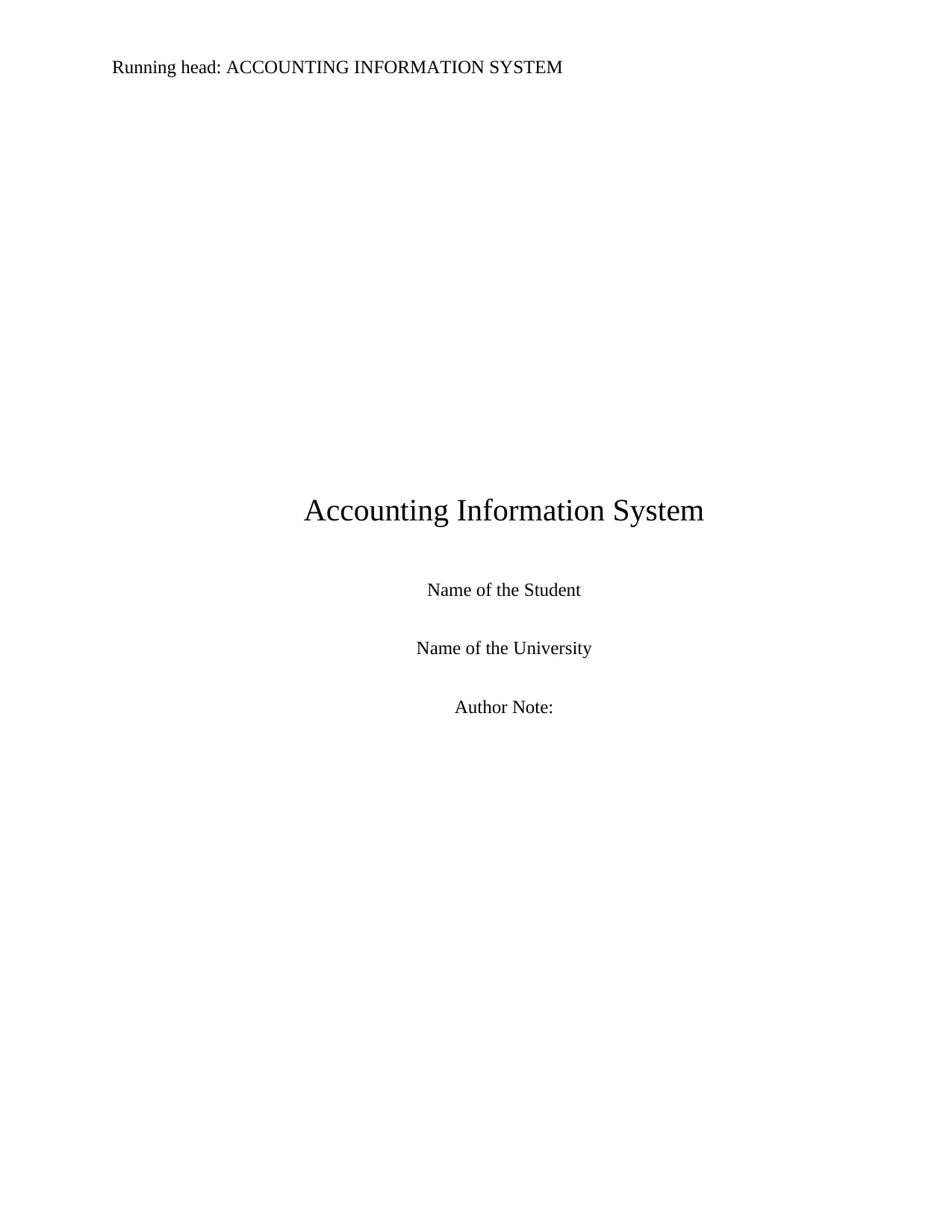
Running head: ACCOUNTING INFORMATION SYSTEM
Accounting Information System
Name of the Student
Name of the University
Author Note:
Accounting Information System
Name of the Student
Name of the University
Author Note:
Paraphrase This Document
Need a fresh take? Get an instant paraphrase of this document with our AI Paraphraser
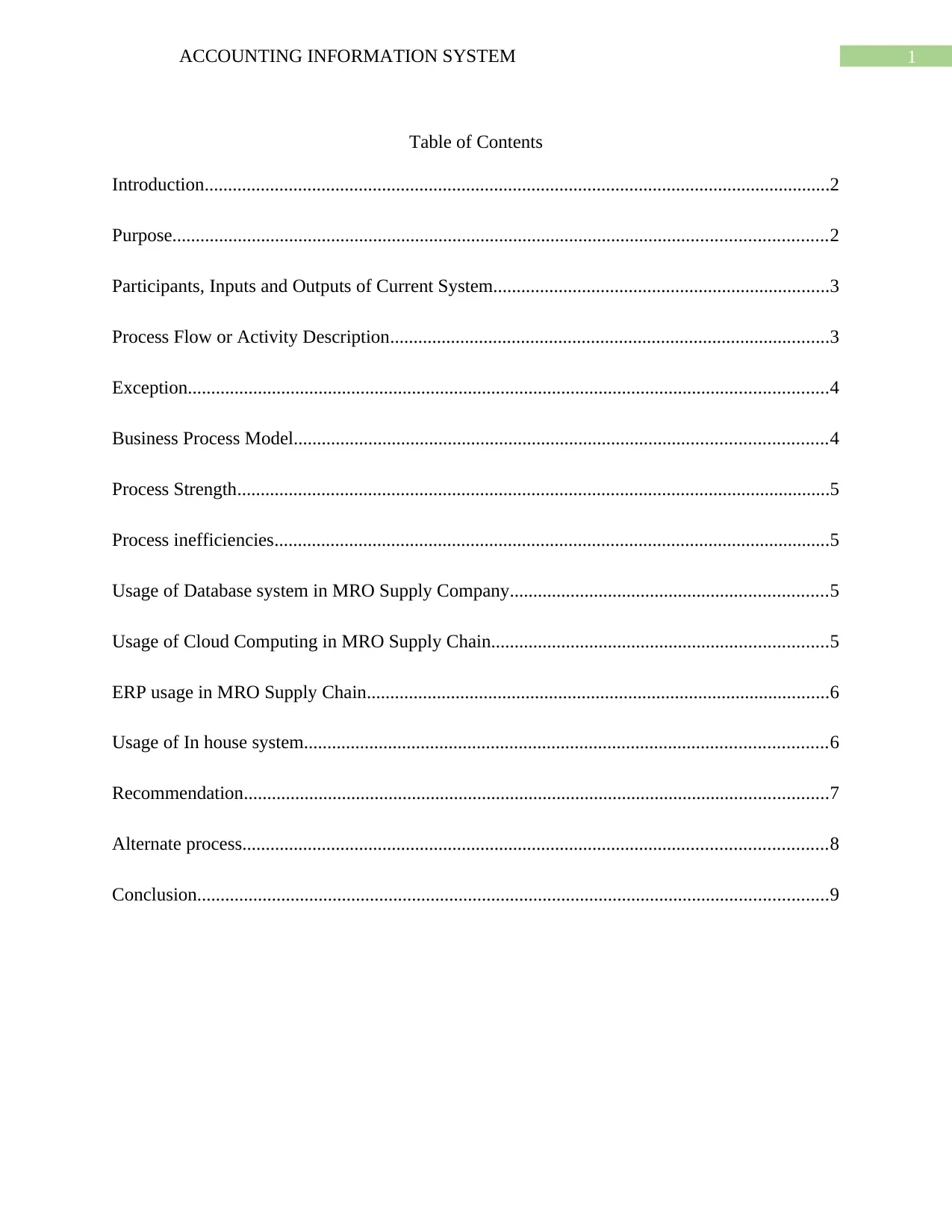
1ACCOUNTING INFORMATION SYSTEM
Table of Contents
Introduction......................................................................................................................................2
Purpose............................................................................................................................................2
Participants, Inputs and Outputs of Current System........................................................................3
Process Flow or Activity Description..............................................................................................3
Exception.........................................................................................................................................4
Business Process Model..................................................................................................................4
Process Strength...............................................................................................................................5
Process inefficiencies.......................................................................................................................5
Usage of Database system in MRO Supply Company....................................................................5
Usage of Cloud Computing in MRO Supply Chain........................................................................5
ERP usage in MRO Supply Chain...................................................................................................6
Usage of In house system................................................................................................................6
Recommendation.............................................................................................................................7
Alternate process.............................................................................................................................8
Conclusion.......................................................................................................................................9
Table of Contents
Introduction......................................................................................................................................2
Purpose............................................................................................................................................2
Participants, Inputs and Outputs of Current System........................................................................3
Process Flow or Activity Description..............................................................................................3
Exception.........................................................................................................................................4
Business Process Model..................................................................................................................4
Process Strength...............................................................................................................................5
Process inefficiencies.......................................................................................................................5
Usage of Database system in MRO Supply Company....................................................................5
Usage of Cloud Computing in MRO Supply Chain........................................................................5
ERP usage in MRO Supply Chain...................................................................................................6
Usage of In house system................................................................................................................6
Recommendation.............................................................................................................................7
Alternate process.............................................................................................................................8
Conclusion.......................................................................................................................................9
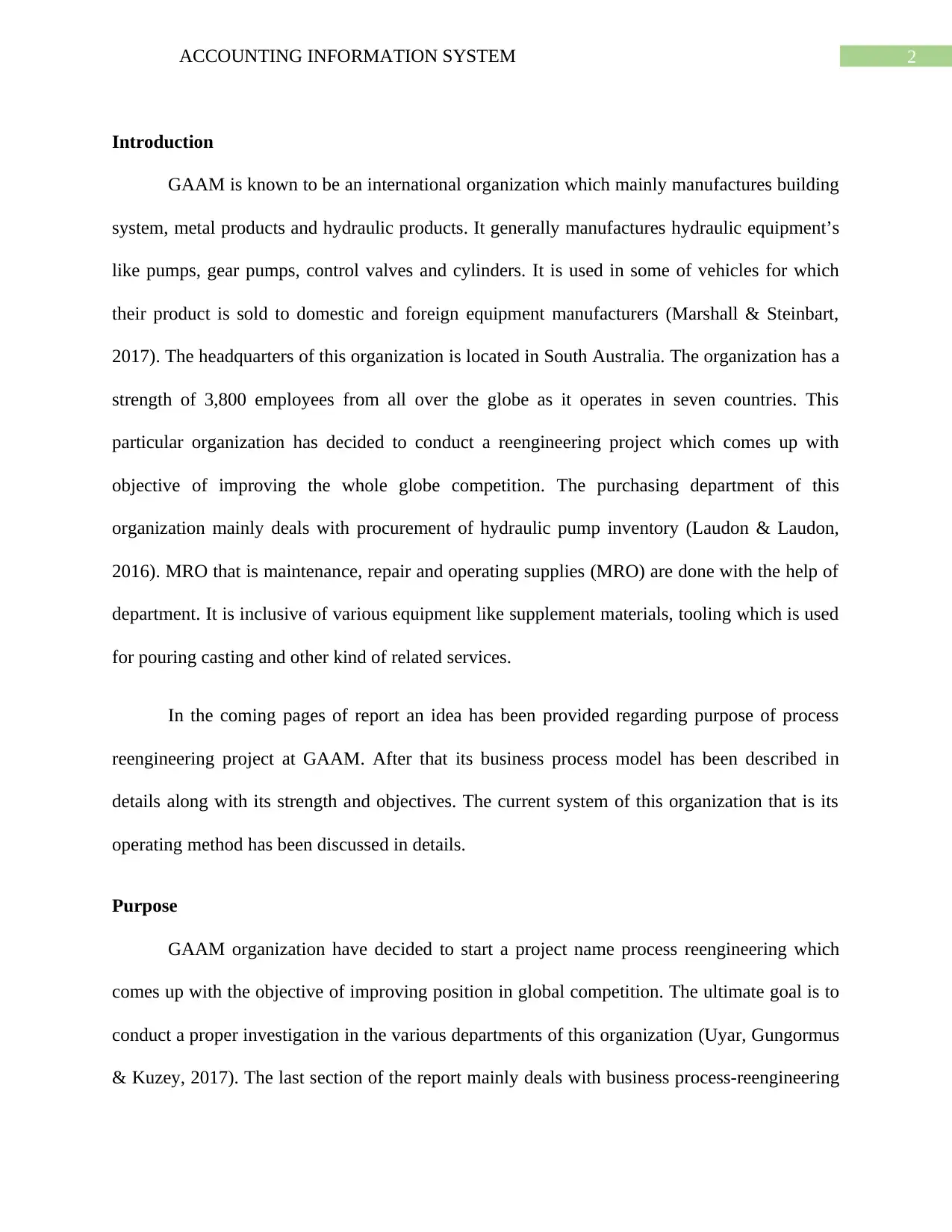
2ACCOUNTING INFORMATION SYSTEM
Introduction
GAAM is known to be an international organization which mainly manufactures building
system, metal products and hydraulic products. It generally manufactures hydraulic equipment’s
like pumps, gear pumps, control valves and cylinders. It is used in some of vehicles for which
their product is sold to domestic and foreign equipment manufacturers (Marshall & Steinbart,
2017). The headquarters of this organization is located in South Australia. The organization has a
strength of 3,800 employees from all over the globe as it operates in seven countries. This
particular organization has decided to conduct a reengineering project which comes up with
objective of improving the whole globe competition. The purchasing department of this
organization mainly deals with procurement of hydraulic pump inventory (Laudon & Laudon,
2016). MRO that is maintenance, repair and operating supplies (MRO) are done with the help of
department. It is inclusive of various equipment like supplement materials, tooling which is used
for pouring casting and other kind of related services.
In the coming pages of report an idea has been provided regarding purpose of process
reengineering project at GAAM. After that its business process model has been described in
details along with its strength and objectives. The current system of this organization that is its
operating method has been discussed in details.
Purpose
GAAM organization have decided to start a project name process reengineering which
comes up with the objective of improving position in global competition. The ultimate goal is to
conduct a proper investigation in the various departments of this organization (Uyar, Gungormus
& Kuzey, 2017). The last section of the report mainly deals with business process-reengineering
Introduction
GAAM is known to be an international organization which mainly manufactures building
system, metal products and hydraulic products. It generally manufactures hydraulic equipment’s
like pumps, gear pumps, control valves and cylinders. It is used in some of vehicles for which
their product is sold to domestic and foreign equipment manufacturers (Marshall & Steinbart,
2017). The headquarters of this organization is located in South Australia. The organization has a
strength of 3,800 employees from all over the globe as it operates in seven countries. This
particular organization has decided to conduct a reengineering project which comes up with
objective of improving the whole globe competition. The purchasing department of this
organization mainly deals with procurement of hydraulic pump inventory (Laudon & Laudon,
2016). MRO that is maintenance, repair and operating supplies (MRO) are done with the help of
department. It is inclusive of various equipment like supplement materials, tooling which is used
for pouring casting and other kind of related services.
In the coming pages of report an idea has been provided regarding purpose of process
reengineering project at GAAM. After that its business process model has been described in
details along with its strength and objectives. The current system of this organization that is its
operating method has been discussed in details.
Purpose
GAAM organization have decided to start a project name process reengineering which
comes up with the objective of improving position in global competition. The ultimate goal is to
conduct a proper investigation in the various departments of this organization (Uyar, Gungormus
& Kuzey, 2017). The last section of the report mainly deals with business process-reengineering
⊘ This is a preview!⊘
Do you want full access?
Subscribe today to unlock all pages.

Trusted by 1+ million students worldwide
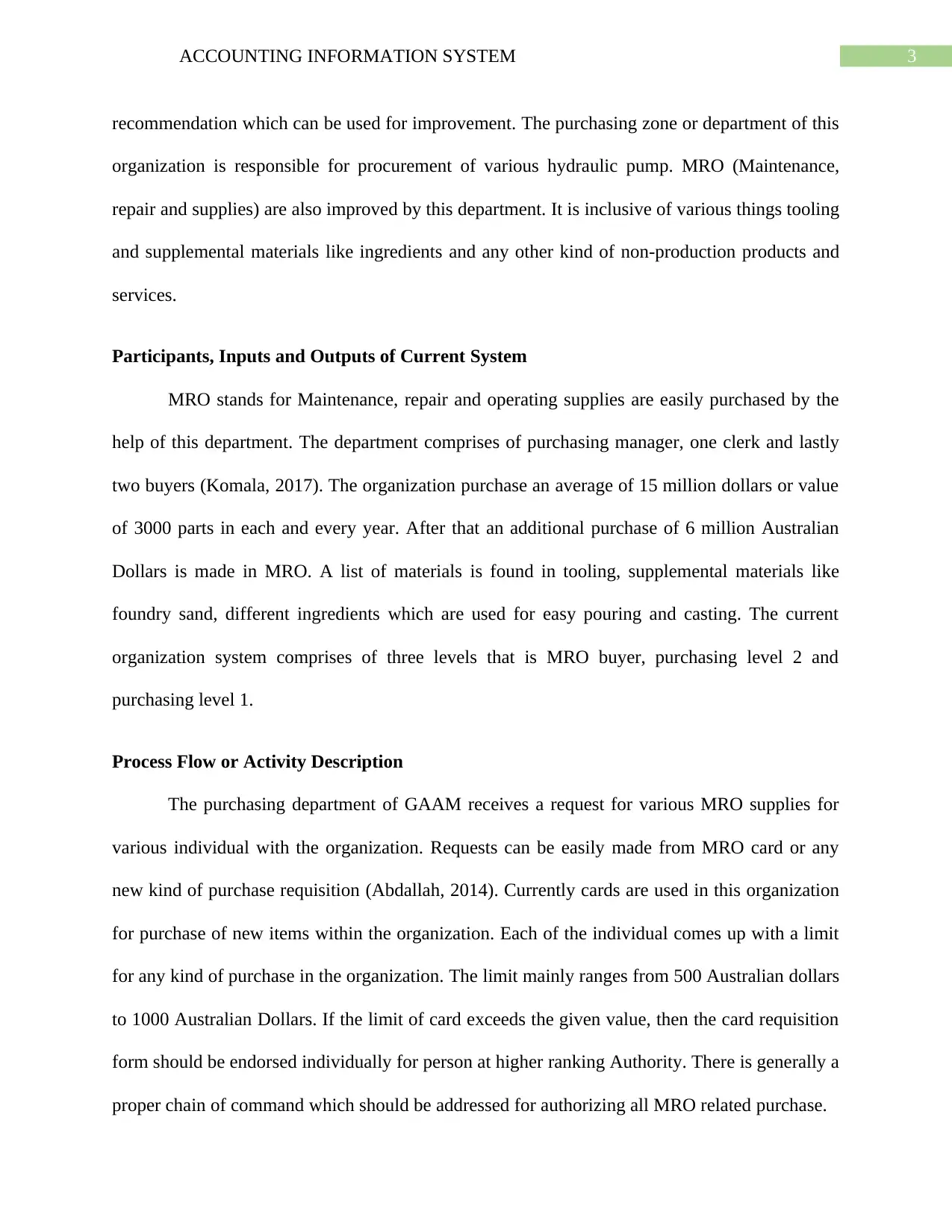
3ACCOUNTING INFORMATION SYSTEM
recommendation which can be used for improvement. The purchasing zone or department of this
organization is responsible for procurement of various hydraulic pump. MRO (Maintenance,
repair and supplies) are also improved by this department. It is inclusive of various things tooling
and supplemental materials like ingredients and any other kind of non-production products and
services.
Participants, Inputs and Outputs of Current System
MRO stands for Maintenance, repair and operating supplies are easily purchased by the
help of this department. The department comprises of purchasing manager, one clerk and lastly
two buyers (Komala, 2017). The organization purchase an average of 15 million dollars or value
of 3000 parts in each and every year. After that an additional purchase of 6 million Australian
Dollars is made in MRO. A list of materials is found in tooling, supplemental materials like
foundry sand, different ingredients which are used for easy pouring and casting. The current
organization system comprises of three levels that is MRO buyer, purchasing level 2 and
purchasing level 1.
Process Flow or Activity Description
The purchasing department of GAAM receives a request for various MRO supplies for
various individual with the organization. Requests can be easily made from MRO card or any
new kind of purchase requisition (Abdallah, 2014). Currently cards are used in this organization
for purchase of new items within the organization. Each of the individual comes up with a limit
for any kind of purchase in the organization. The limit mainly ranges from 500 Australian dollars
to 1000 Australian Dollars. If the limit of card exceeds the given value, then the card requisition
form should be endorsed individually for person at higher ranking Authority. There is generally a
proper chain of command which should be addressed for authorizing all MRO related purchase.
recommendation which can be used for improvement. The purchasing zone or department of this
organization is responsible for procurement of various hydraulic pump. MRO (Maintenance,
repair and supplies) are also improved by this department. It is inclusive of various things tooling
and supplemental materials like ingredients and any other kind of non-production products and
services.
Participants, Inputs and Outputs of Current System
MRO stands for Maintenance, repair and operating supplies are easily purchased by the
help of this department. The department comprises of purchasing manager, one clerk and lastly
two buyers (Komala, 2017). The organization purchase an average of 15 million dollars or value
of 3000 parts in each and every year. After that an additional purchase of 6 million Australian
Dollars is made in MRO. A list of materials is found in tooling, supplemental materials like
foundry sand, different ingredients which are used for easy pouring and casting. The current
organization system comprises of three levels that is MRO buyer, purchasing level 2 and
purchasing level 1.
Process Flow or Activity Description
The purchasing department of GAAM receives a request for various MRO supplies for
various individual with the organization. Requests can be easily made from MRO card or any
new kind of purchase requisition (Abdallah, 2014). Currently cards are used in this organization
for purchase of new items within the organization. Each of the individual comes up with a limit
for any kind of purchase in the organization. The limit mainly ranges from 500 Australian dollars
to 1000 Australian Dollars. If the limit of card exceeds the given value, then the card requisition
form should be endorsed individually for person at higher ranking Authority. There is generally a
proper chain of command which should be addressed for authorizing all MRO related purchase.
Paraphrase This Document
Need a fresh take? Get an instant paraphrase of this document with our AI Paraphraser
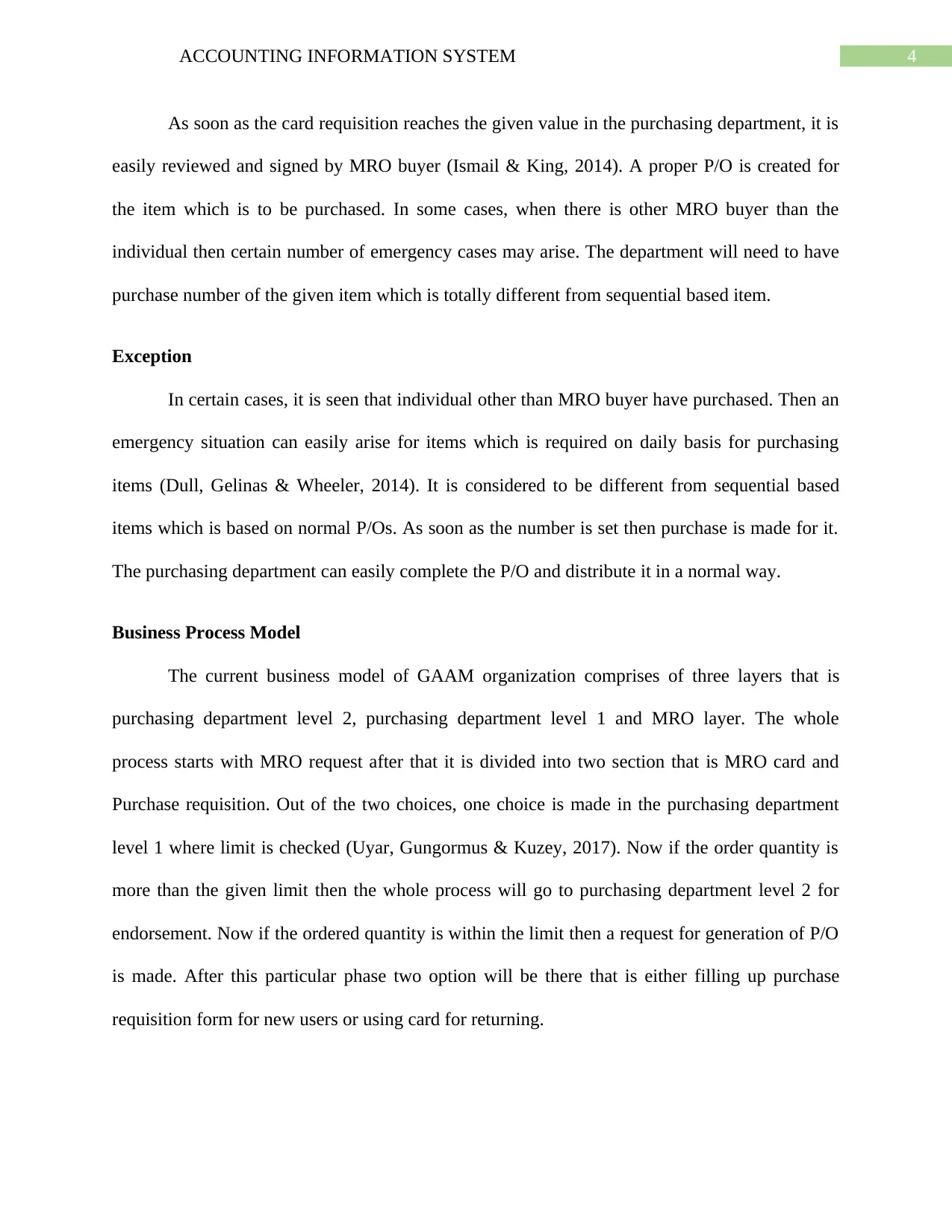
4ACCOUNTING INFORMATION SYSTEM
As soon as the card requisition reaches the given value in the purchasing department, it is
easily reviewed and signed by MRO buyer (Ismail & King, 2014). A proper P/O is created for
the item which is to be purchased. In some cases, when there is other MRO buyer than the
individual then certain number of emergency cases may arise. The department will need to have
purchase number of the given item which is totally different from sequential based item.
Exception
In certain cases, it is seen that individual other than MRO buyer have purchased. Then an
emergency situation can easily arise for items which is required on daily basis for purchasing
items (Dull, Gelinas & Wheeler, 2014). It is considered to be different from sequential based
items which is based on normal P/Os. As soon as the number is set then purchase is made for it.
The purchasing department can easily complete the P/O and distribute it in a normal way.
Business Process Model
The current business model of GAAM organization comprises of three layers that is
purchasing department level 2, purchasing department level 1 and MRO layer. The whole
process starts with MRO request after that it is divided into two section that is MRO card and
Purchase requisition. Out of the two choices, one choice is made in the purchasing department
level 1 where limit is checked (Uyar, Gungormus & Kuzey, 2017). Now if the order quantity is
more than the given limit then the whole process will go to purchasing department level 2 for
endorsement. Now if the ordered quantity is within the limit then a request for generation of P/O
is made. After this particular phase two option will be there that is either filling up purchase
requisition form for new users or using card for returning.
As soon as the card requisition reaches the given value in the purchasing department, it is
easily reviewed and signed by MRO buyer (Ismail & King, 2014). A proper P/O is created for
the item which is to be purchased. In some cases, when there is other MRO buyer than the
individual then certain number of emergency cases may arise. The department will need to have
purchase number of the given item which is totally different from sequential based item.
Exception
In certain cases, it is seen that individual other than MRO buyer have purchased. Then an
emergency situation can easily arise for items which is required on daily basis for purchasing
items (Dull, Gelinas & Wheeler, 2014). It is considered to be different from sequential based
items which is based on normal P/Os. As soon as the number is set then purchase is made for it.
The purchasing department can easily complete the P/O and distribute it in a normal way.
Business Process Model
The current business model of GAAM organization comprises of three layers that is
purchasing department level 2, purchasing department level 1 and MRO layer. The whole
process starts with MRO request after that it is divided into two section that is MRO card and
Purchase requisition. Out of the two choices, one choice is made in the purchasing department
level 1 where limit is checked (Uyar, Gungormus & Kuzey, 2017). Now if the order quantity is
more than the given limit then the whole process will go to purchasing department level 2 for
endorsement. Now if the ordered quantity is within the limit then a request for generation of P/O
is made. After this particular phase two option will be there that is either filling up purchase
requisition form for new users or using card for returning.
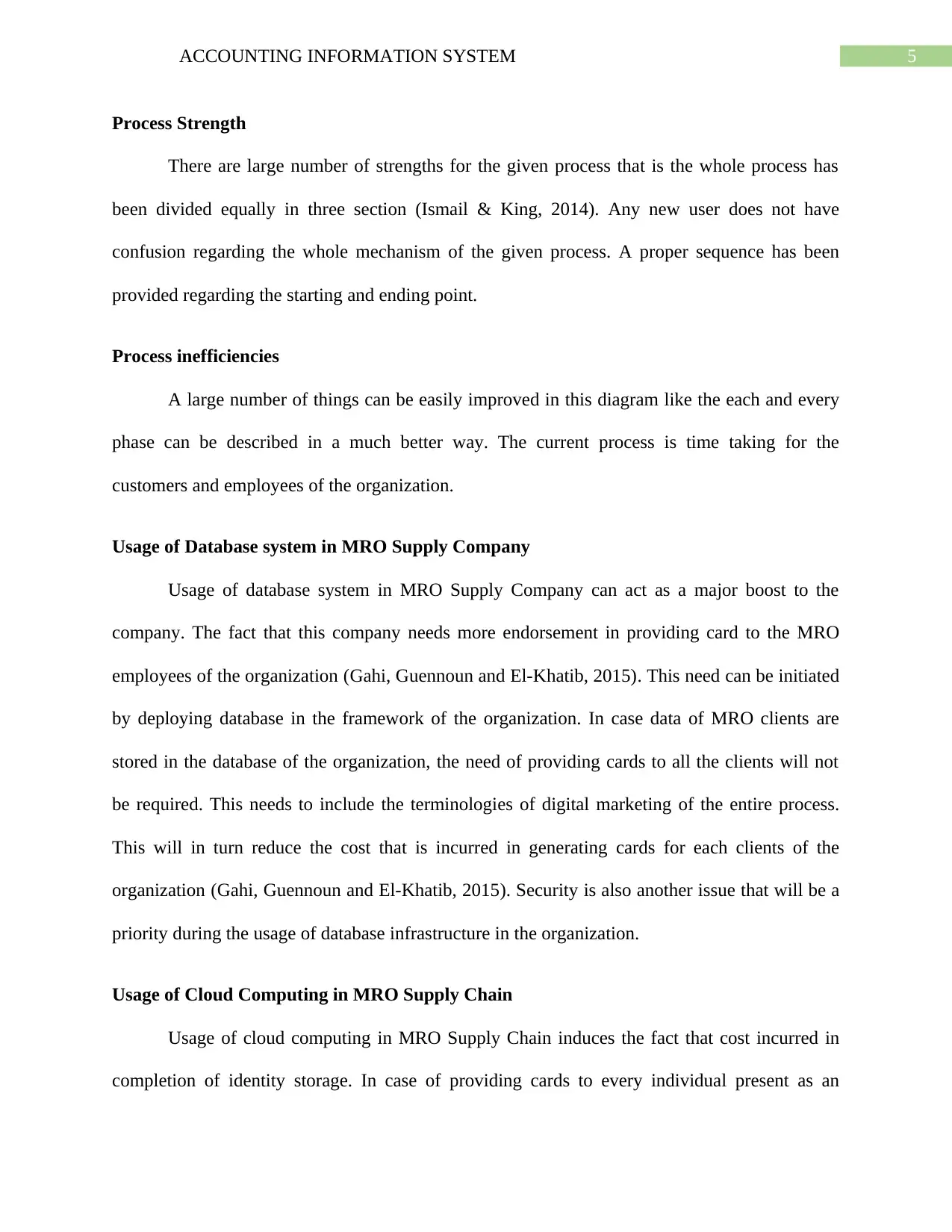
5ACCOUNTING INFORMATION SYSTEM
Process Strength
There are large number of strengths for the given process that is the whole process has
been divided equally in three section (Ismail & King, 2014). Any new user does not have
confusion regarding the whole mechanism of the given process. A proper sequence has been
provided regarding the starting and ending point.
Process inefficiencies
A large number of things can be easily improved in this diagram like the each and every
phase can be described in a much better way. The current process is time taking for the
customers and employees of the organization.
Usage of Database system in MRO Supply Company
Usage of database system in MRO Supply Company can act as a major boost to the
company. The fact that this company needs more endorsement in providing card to the MRO
employees of the organization (Gahi, Guennoun and El-Khatib, 2015). This need can be initiated
by deploying database in the framework of the organization. In case data of MRO clients are
stored in the database of the organization, the need of providing cards to all the clients will not
be required. This needs to include the terminologies of digital marketing of the entire process.
This will in turn reduce the cost that is incurred in generating cards for each clients of the
organization (Gahi, Guennoun and El-Khatib, 2015). Security is also another issue that will be a
priority during the usage of database infrastructure in the organization.
Usage of Cloud Computing in MRO Supply Chain
Usage of cloud computing in MRO Supply Chain induces the fact that cost incurred in
completion of identity storage. In case of providing cards to every individual present as an
Process Strength
There are large number of strengths for the given process that is the whole process has
been divided equally in three section (Ismail & King, 2014). Any new user does not have
confusion regarding the whole mechanism of the given process. A proper sequence has been
provided regarding the starting and ending point.
Process inefficiencies
A large number of things can be easily improved in this diagram like the each and every
phase can be described in a much better way. The current process is time taking for the
customers and employees of the organization.
Usage of Database system in MRO Supply Company
Usage of database system in MRO Supply Company can act as a major boost to the
company. The fact that this company needs more endorsement in providing card to the MRO
employees of the organization (Gahi, Guennoun and El-Khatib, 2015). This need can be initiated
by deploying database in the framework of the organization. In case data of MRO clients are
stored in the database of the organization, the need of providing cards to all the clients will not
be required. This needs to include the terminologies of digital marketing of the entire process.
This will in turn reduce the cost that is incurred in generating cards for each clients of the
organization (Gahi, Guennoun and El-Khatib, 2015). Security is also another issue that will be a
priority during the usage of database infrastructure in the organization.
Usage of Cloud Computing in MRO Supply Chain
Usage of cloud computing in MRO Supply Chain induces the fact that cost incurred in
completion of identity storage. In case of providing cards to every individual present as an
⊘ This is a preview!⊘
Do you want full access?
Subscribe today to unlock all pages.

Trusted by 1+ million students worldwide
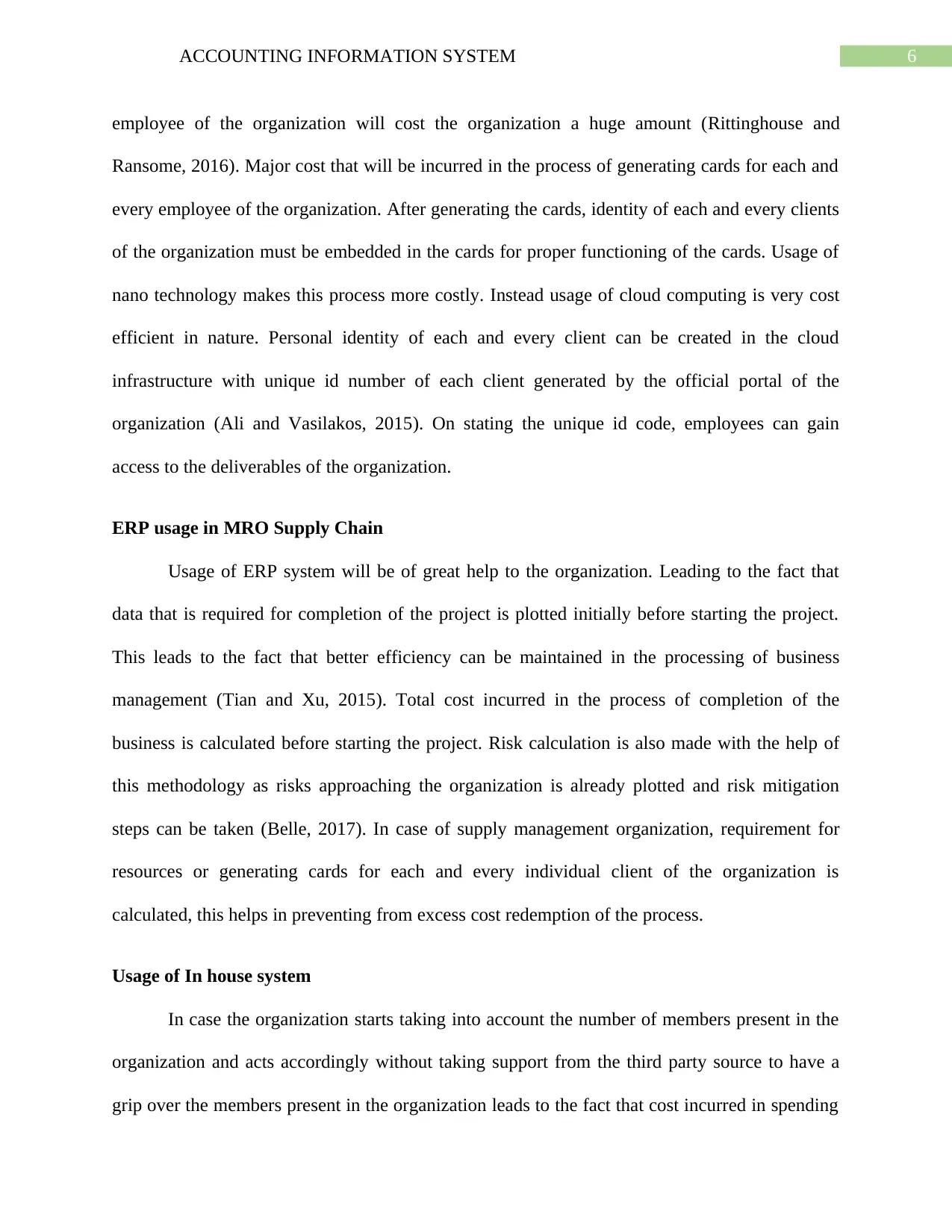
6ACCOUNTING INFORMATION SYSTEM
employee of the organization will cost the organization a huge amount (Rittinghouse and
Ransome, 2016). Major cost that will be incurred in the process of generating cards for each and
every employee of the organization. After generating the cards, identity of each and every clients
of the organization must be embedded in the cards for proper functioning of the cards. Usage of
nano technology makes this process more costly. Instead usage of cloud computing is very cost
efficient in nature. Personal identity of each and every client can be created in the cloud
infrastructure with unique id number of each client generated by the official portal of the
organization (Ali and Vasilakos, 2015). On stating the unique id code, employees can gain
access to the deliverables of the organization.
ERP usage in MRO Supply Chain
Usage of ERP system will be of great help to the organization. Leading to the fact that
data that is required for completion of the project is plotted initially before starting the project.
This leads to the fact that better efficiency can be maintained in the processing of business
management (Tian and Xu, 2015). Total cost incurred in the process of completion of the
business is calculated before starting the project. Risk calculation is also made with the help of
this methodology as risks approaching the organization is already plotted and risk mitigation
steps can be taken (Belle, 2017). In case of supply management organization, requirement for
resources or generating cards for each and every individual client of the organization is
calculated, this helps in preventing from excess cost redemption of the process.
Usage of In house system
In case the organization starts taking into account the number of members present in the
organization and acts accordingly without taking support from the third party source to have a
grip over the members present in the organization leads to the fact that cost incurred in spending
employee of the organization will cost the organization a huge amount (Rittinghouse and
Ransome, 2016). Major cost that will be incurred in the process of generating cards for each and
every employee of the organization. After generating the cards, identity of each and every clients
of the organization must be embedded in the cards for proper functioning of the cards. Usage of
nano technology makes this process more costly. Instead usage of cloud computing is very cost
efficient in nature. Personal identity of each and every client can be created in the cloud
infrastructure with unique id number of each client generated by the official portal of the
organization (Ali and Vasilakos, 2015). On stating the unique id code, employees can gain
access to the deliverables of the organization.
ERP usage in MRO Supply Chain
Usage of ERP system will be of great help to the organization. Leading to the fact that
data that is required for completion of the project is plotted initially before starting the project.
This leads to the fact that better efficiency can be maintained in the processing of business
management (Tian and Xu, 2015). Total cost incurred in the process of completion of the
business is calculated before starting the project. Risk calculation is also made with the help of
this methodology as risks approaching the organization is already plotted and risk mitigation
steps can be taken (Belle, 2017). In case of supply management organization, requirement for
resources or generating cards for each and every individual client of the organization is
calculated, this helps in preventing from excess cost redemption of the process.
Usage of In house system
In case the organization starts taking into account the number of members present in the
organization and acts accordingly without taking support from the third party source to have a
grip over the members present in the organization leads to the fact that cost incurred in spending
Paraphrase This Document
Need a fresh take? Get an instant paraphrase of this document with our AI Paraphraser
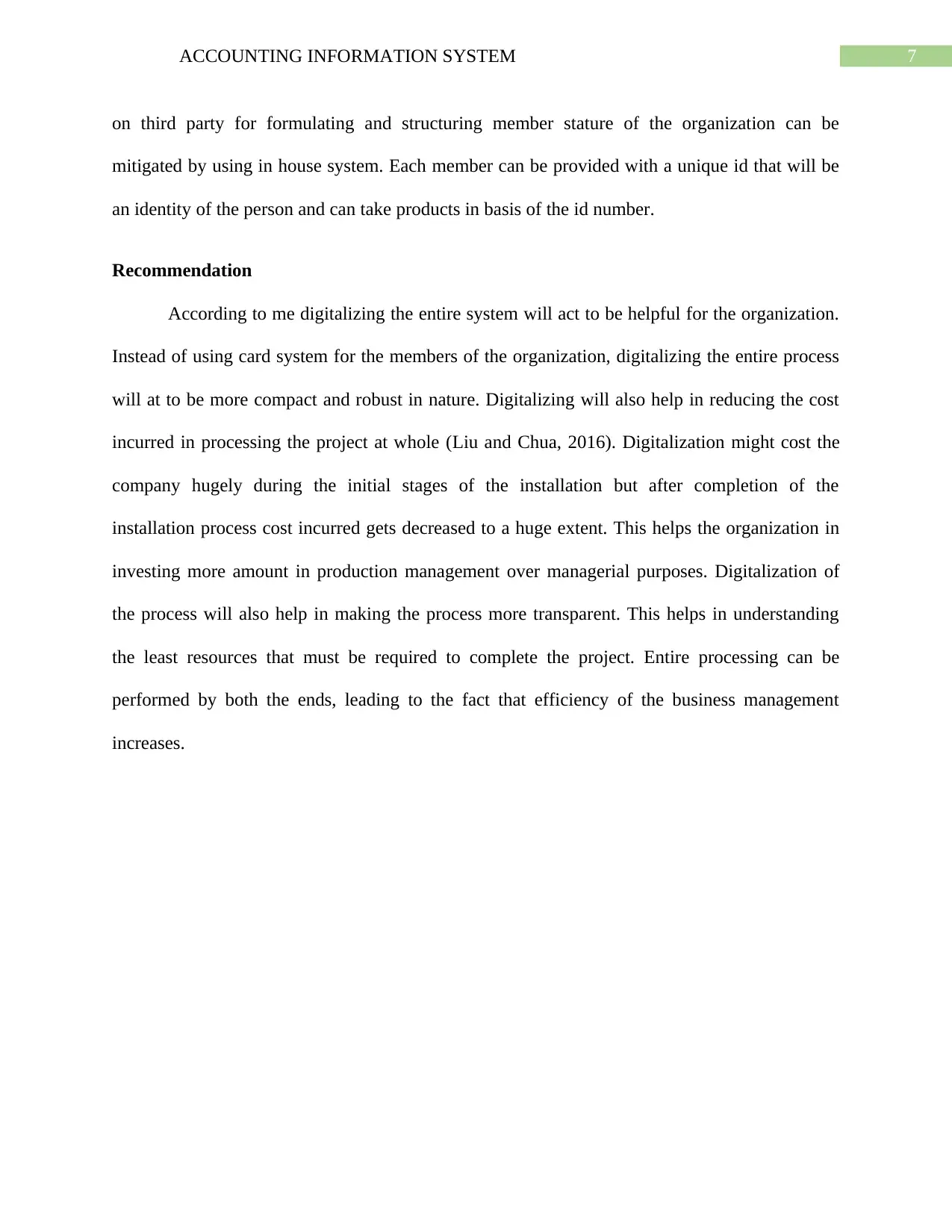
7ACCOUNTING INFORMATION SYSTEM
on third party for formulating and structuring member stature of the organization can be
mitigated by using in house system. Each member can be provided with a unique id that will be
an identity of the person and can take products in basis of the id number.
Recommendation
According to me digitalizing the entire system will act to be helpful for the organization.
Instead of using card system for the members of the organization, digitalizing the entire process
will at to be more compact and robust in nature. Digitalizing will also help in reducing the cost
incurred in processing the project at whole (Liu and Chua, 2016). Digitalization might cost the
company hugely during the initial stages of the installation but after completion of the
installation process cost incurred gets decreased to a huge extent. This helps the organization in
investing more amount in production management over managerial purposes. Digitalization of
the process will also help in making the process more transparent. This helps in understanding
the least resources that must be required to complete the project. Entire processing can be
performed by both the ends, leading to the fact that efficiency of the business management
increases.
on third party for formulating and structuring member stature of the organization can be
mitigated by using in house system. Each member can be provided with a unique id that will be
an identity of the person and can take products in basis of the id number.
Recommendation
According to me digitalizing the entire system will act to be helpful for the organization.
Instead of using card system for the members of the organization, digitalizing the entire process
will at to be more compact and robust in nature. Digitalizing will also help in reducing the cost
incurred in processing the project at whole (Liu and Chua, 2016). Digitalization might cost the
company hugely during the initial stages of the installation but after completion of the
installation process cost incurred gets decreased to a huge extent. This helps the organization in
investing more amount in production management over managerial purposes. Digitalization of
the process will also help in making the process more transparent. This helps in understanding
the least resources that must be required to complete the project. Entire processing can be
performed by both the ends, leading to the fact that efficiency of the business management
increases.
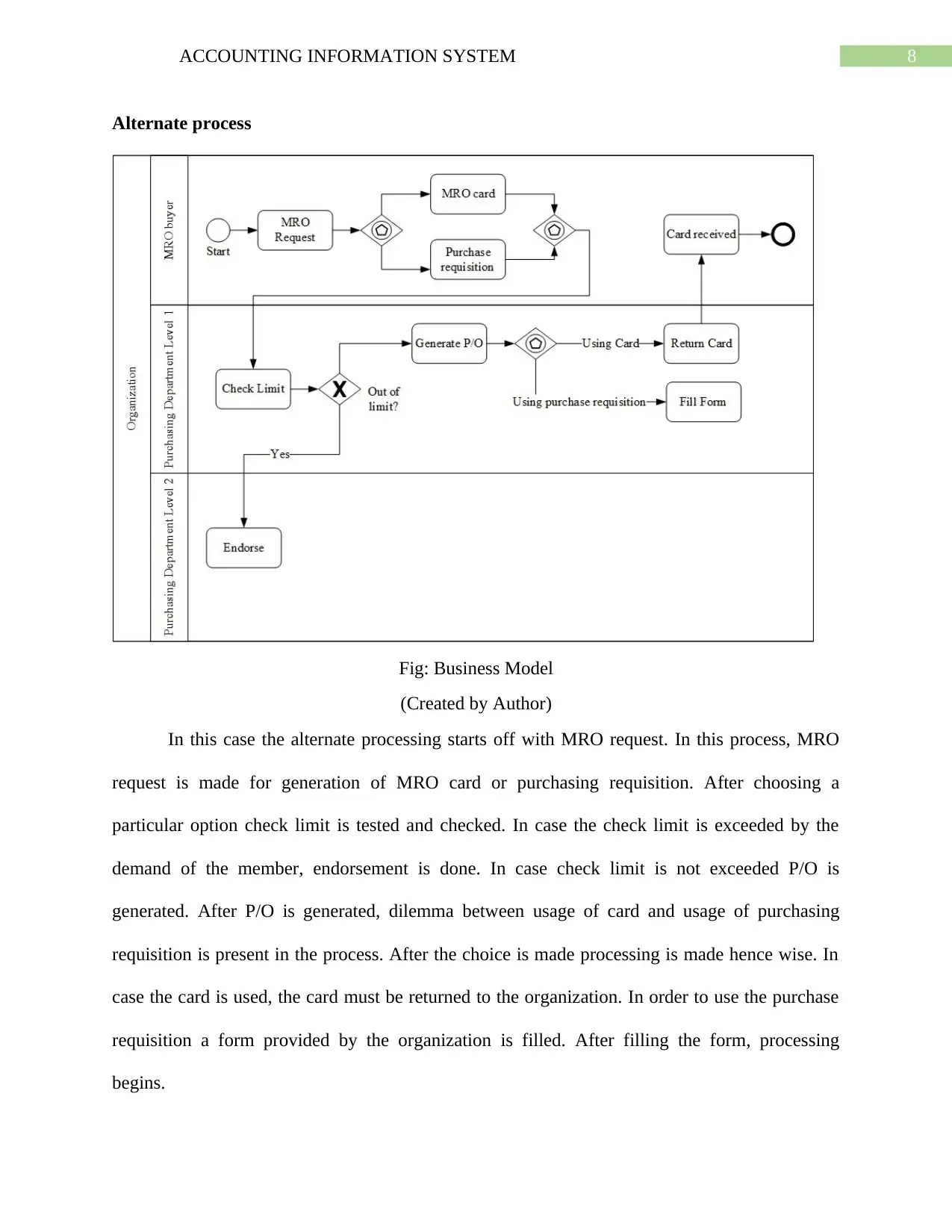
8ACCOUNTING INFORMATION SYSTEM
Alternate process
Fig: Business Model
(Created by Author)
In this case the alternate processing starts off with MRO request. In this process, MRO
request is made for generation of MRO card or purchasing requisition. After choosing a
particular option check limit is tested and checked. In case the check limit is exceeded by the
demand of the member, endorsement is done. In case check limit is not exceeded P/O is
generated. After P/O is generated, dilemma between usage of card and usage of purchasing
requisition is present in the process. After the choice is made processing is made hence wise. In
case the card is used, the card must be returned to the organization. In order to use the purchase
requisition a form provided by the organization is filled. After filling the form, processing
begins.
Alternate process
Fig: Business Model
(Created by Author)
In this case the alternate processing starts off with MRO request. In this process, MRO
request is made for generation of MRO card or purchasing requisition. After choosing a
particular option check limit is tested and checked. In case the check limit is exceeded by the
demand of the member, endorsement is done. In case check limit is not exceeded P/O is
generated. After P/O is generated, dilemma between usage of card and usage of purchasing
requisition is present in the process. After the choice is made processing is made hence wise. In
case the card is used, the card must be returned to the organization. In order to use the purchase
requisition a form provided by the organization is filled. After filling the form, processing
begins.
⊘ This is a preview!⊘
Do you want full access?
Subscribe today to unlock all pages.

Trusted by 1+ million students worldwide
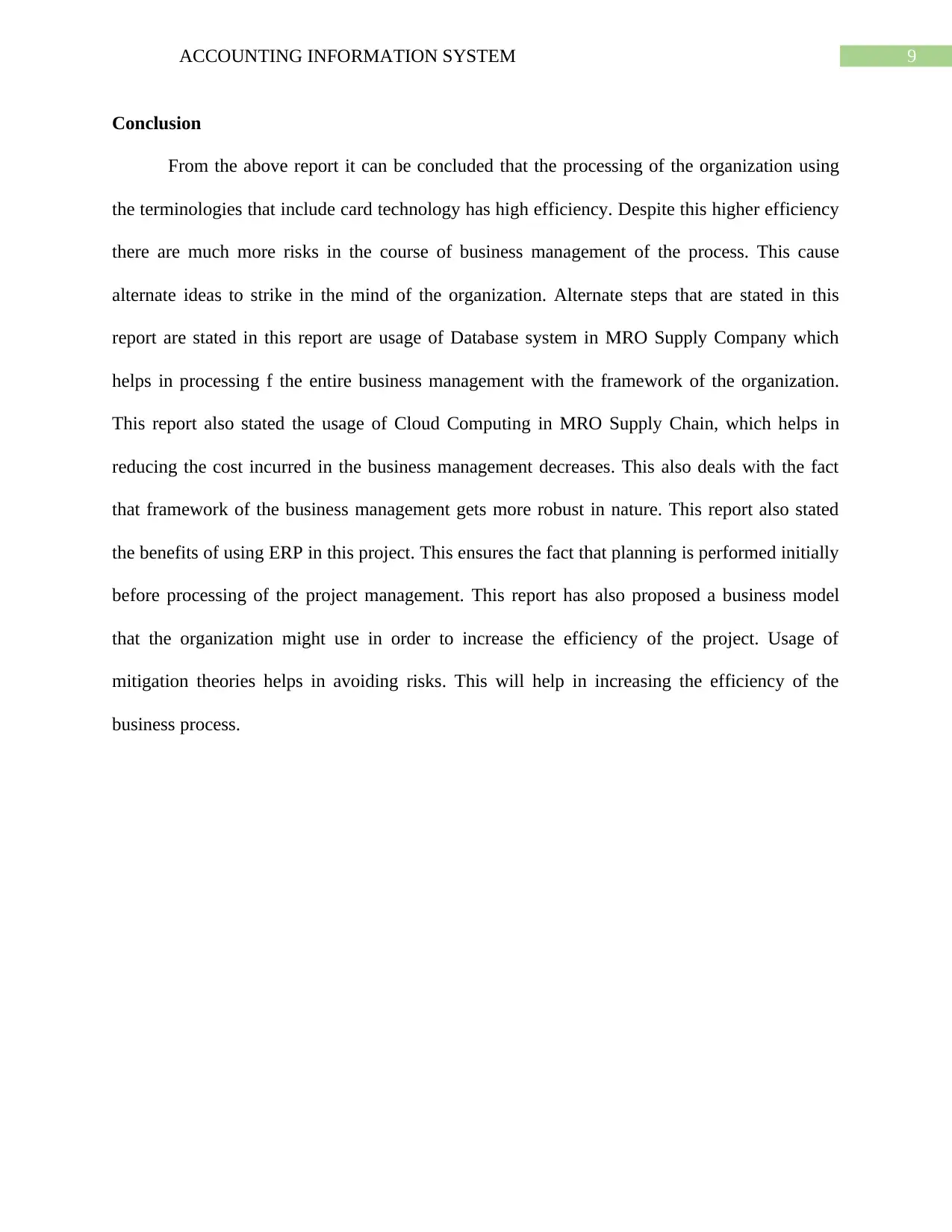
9ACCOUNTING INFORMATION SYSTEM
Conclusion
From the above report it can be concluded that the processing of the organization using
the terminologies that include card technology has high efficiency. Despite this higher efficiency
there are much more risks in the course of business management of the process. This cause
alternate ideas to strike in the mind of the organization. Alternate steps that are stated in this
report are stated in this report are usage of Database system in MRO Supply Company which
helps in processing f the entire business management with the framework of the organization.
This report also stated the usage of Cloud Computing in MRO Supply Chain, which helps in
reducing the cost incurred in the business management decreases. This also deals with the fact
that framework of the business management gets more robust in nature. This report also stated
the benefits of using ERP in this project. This ensures the fact that planning is performed initially
before processing of the project management. This report has also proposed a business model
that the organization might use in order to increase the efficiency of the project. Usage of
mitigation theories helps in avoiding risks. This will help in increasing the efficiency of the
business process.
Conclusion
From the above report it can be concluded that the processing of the organization using
the terminologies that include card technology has high efficiency. Despite this higher efficiency
there are much more risks in the course of business management of the process. This cause
alternate ideas to strike in the mind of the organization. Alternate steps that are stated in this
report are stated in this report are usage of Database system in MRO Supply Company which
helps in processing f the entire business management with the framework of the organization.
This report also stated the usage of Cloud Computing in MRO Supply Chain, which helps in
reducing the cost incurred in the business management decreases. This also deals with the fact
that framework of the business management gets more robust in nature. This report also stated
the benefits of using ERP in this project. This ensures the fact that planning is performed initially
before processing of the project management. This report has also proposed a business model
that the organization might use in order to increase the efficiency of the project. Usage of
mitigation theories helps in avoiding risks. This will help in increasing the efficiency of the
business process.
Paraphrase This Document
Need a fresh take? Get an instant paraphrase of this document with our AI Paraphraser
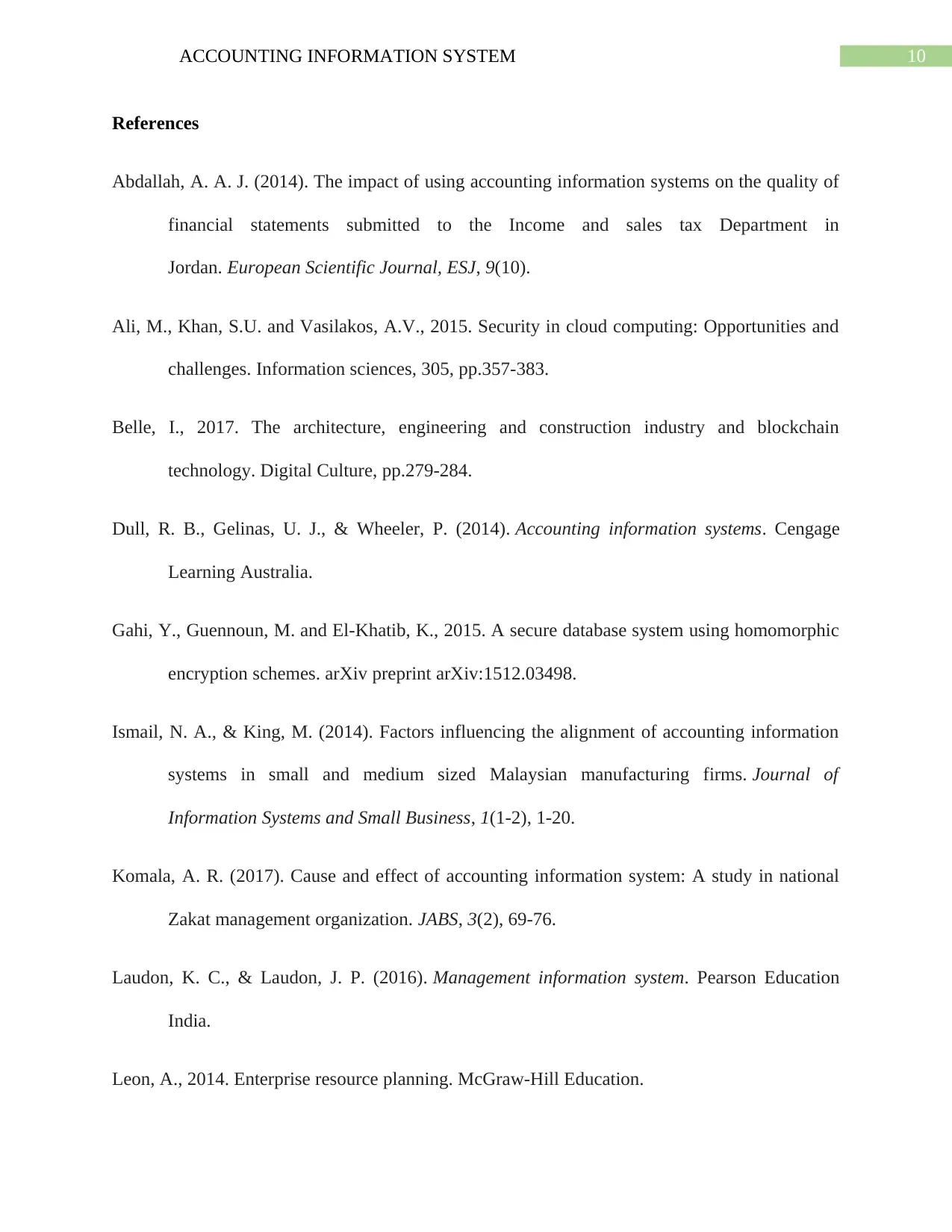
10ACCOUNTING INFORMATION SYSTEM
References
Abdallah, A. A. J. (2014). The impact of using accounting information systems on the quality of
financial statements submitted to the Income and sales tax Department in
Jordan. European Scientific Journal, ESJ, 9(10).
Ali, M., Khan, S.U. and Vasilakos, A.V., 2015. Security in cloud computing: Opportunities and
challenges. Information sciences, 305, pp.357-383.
Belle, I., 2017. The architecture, engineering and construction industry and blockchain
technology. Digital Culture, pp.279-284.
Dull, R. B., Gelinas, U. J., & Wheeler, P. (2014). Accounting information systems. Cengage
Learning Australia.
Gahi, Y., Guennoun, M. and El-Khatib, K., 2015. A secure database system using homomorphic
encryption schemes. arXiv preprint arXiv:1512.03498.
Ismail, N. A., & King, M. (2014). Factors influencing the alignment of accounting information
systems in small and medium sized Malaysian manufacturing firms. Journal of
Information Systems and Small Business, 1(1-2), 1-20.
Komala, A. R. (2017). Cause and effect of accounting information system: A study in national
Zakat management organization. JABS, 3(2), 69-76.
Laudon, K. C., & Laudon, J. P. (2016). Management information system. Pearson Education
India.
Leon, A., 2014. Enterprise resource planning. McGraw-Hill Education.
References
Abdallah, A. A. J. (2014). The impact of using accounting information systems on the quality of
financial statements submitted to the Income and sales tax Department in
Jordan. European Scientific Journal, ESJ, 9(10).
Ali, M., Khan, S.U. and Vasilakos, A.V., 2015. Security in cloud computing: Opportunities and
challenges. Information sciences, 305, pp.357-383.
Belle, I., 2017. The architecture, engineering and construction industry and blockchain
technology. Digital Culture, pp.279-284.
Dull, R. B., Gelinas, U. J., & Wheeler, P. (2014). Accounting information systems. Cengage
Learning Australia.
Gahi, Y., Guennoun, M. and El-Khatib, K., 2015. A secure database system using homomorphic
encryption schemes. arXiv preprint arXiv:1512.03498.
Ismail, N. A., & King, M. (2014). Factors influencing the alignment of accounting information
systems in small and medium sized Malaysian manufacturing firms. Journal of
Information Systems and Small Business, 1(1-2), 1-20.
Komala, A. R. (2017). Cause and effect of accounting information system: A study in national
Zakat management organization. JABS, 3(2), 69-76.
Laudon, K. C., & Laudon, J. P. (2016). Management information system. Pearson Education
India.
Leon, A., 2014. Enterprise resource planning. McGraw-Hill Education.
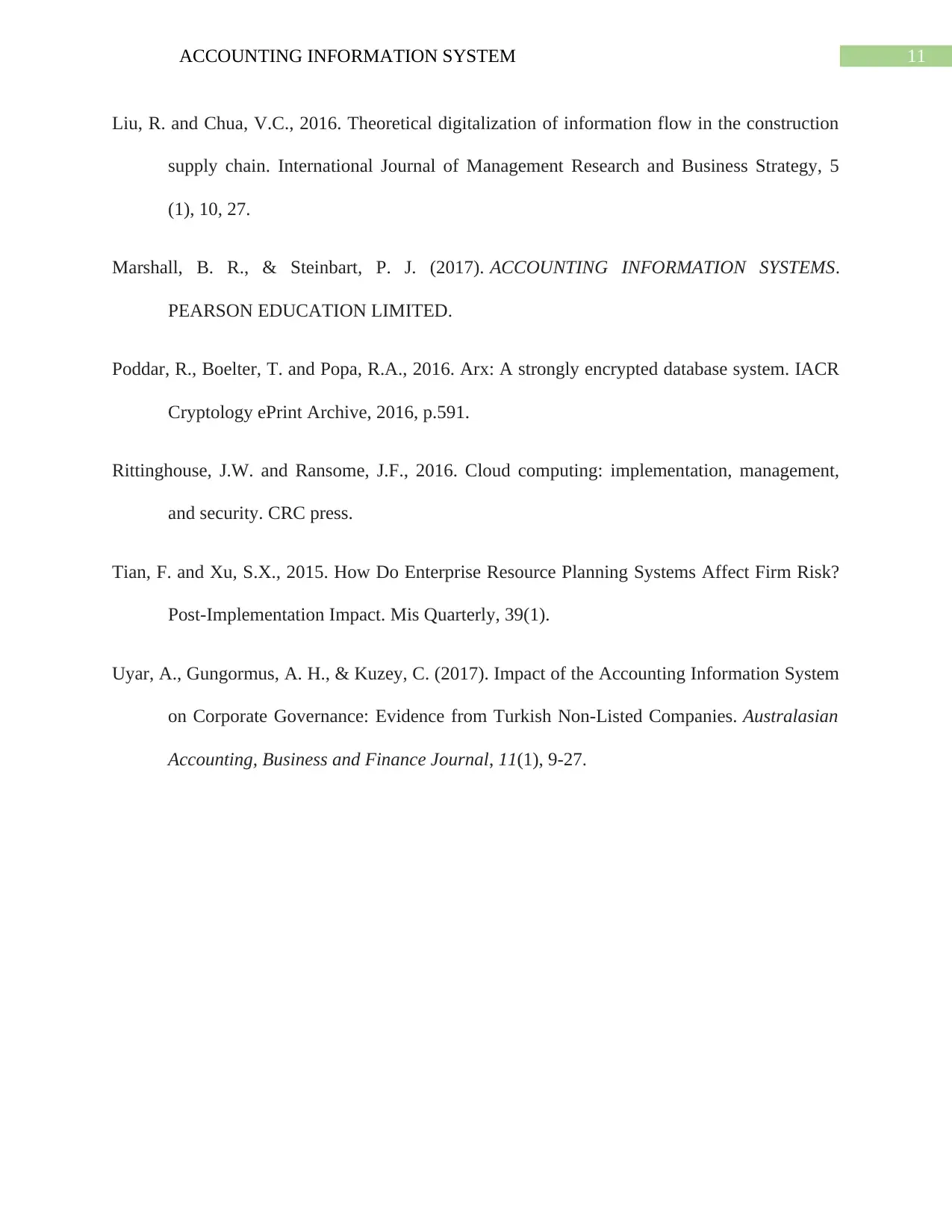
11ACCOUNTING INFORMATION SYSTEM
Liu, R. and Chua, V.C., 2016. Theoretical digitalization of information flow in the construction
supply chain. International Journal of Management Research and Business Strategy, 5
(1), 10, 27.
Marshall, B. R., & Steinbart, P. J. (2017). ACCOUNTING INFORMATION SYSTEMS.
PEARSON EDUCATION LIMITED.
Poddar, R., Boelter, T. and Popa, R.A., 2016. Arx: A strongly encrypted database system. IACR
Cryptology ePrint Archive, 2016, p.591.
Rittinghouse, J.W. and Ransome, J.F., 2016. Cloud computing: implementation, management,
and security. CRC press.
Tian, F. and Xu, S.X., 2015. How Do Enterprise Resource Planning Systems Affect Firm Risk?
Post-Implementation Impact. Mis Quarterly, 39(1).
Uyar, A., Gungormus, A. H., & Kuzey, C. (2017). Impact of the Accounting Information System
on Corporate Governance: Evidence from Turkish Non-Listed Companies. Australasian
Accounting, Business and Finance Journal, 11(1), 9-27.
Liu, R. and Chua, V.C., 2016. Theoretical digitalization of information flow in the construction
supply chain. International Journal of Management Research and Business Strategy, 5
(1), 10, 27.
Marshall, B. R., & Steinbart, P. J. (2017). ACCOUNTING INFORMATION SYSTEMS.
PEARSON EDUCATION LIMITED.
Poddar, R., Boelter, T. and Popa, R.A., 2016. Arx: A strongly encrypted database system. IACR
Cryptology ePrint Archive, 2016, p.591.
Rittinghouse, J.W. and Ransome, J.F., 2016. Cloud computing: implementation, management,
and security. CRC press.
Tian, F. and Xu, S.X., 2015. How Do Enterprise Resource Planning Systems Affect Firm Risk?
Post-Implementation Impact. Mis Quarterly, 39(1).
Uyar, A., Gungormus, A. H., & Kuzey, C. (2017). Impact of the Accounting Information System
on Corporate Governance: Evidence from Turkish Non-Listed Companies. Australasian
Accounting, Business and Finance Journal, 11(1), 9-27.
⊘ This is a preview!⊘
Do you want full access?
Subscribe today to unlock all pages.

Trusted by 1+ million students worldwide
1 out of 12
Related Documents
Your All-in-One AI-Powered Toolkit for Academic Success.
+13062052269
info@desklib.com
Available 24*7 on WhatsApp / Email
![[object Object]](/_next/static/media/star-bottom.7253800d.svg)
Unlock your academic potential
Copyright © 2020–2025 A2Z Services. All Rights Reserved. Developed and managed by ZUCOL.





